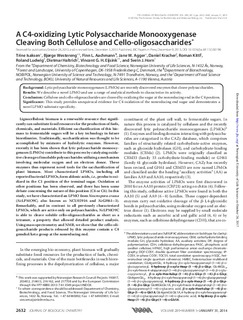A C4-oxidizing lytic polysaccharide monooxygenase cleaving both cellulose and cello-oligosaccharides
Isaksen, Trine; Westereng, Bjørge; Aachmann, Finn Lillelund; Agger, Jane; Kracher, Daniel; Kittl, Roman; Ludwig, R.; Haltrich, Dietmar; Eijsink, Vincent; Horn, Svein Jarle
Journal article, Peer reviewed
Published version
Permanent lenke
http://hdl.handle.net/11250/2461993Utgivelsesdato
2014Metadata
Vis full innførselSamlinger
Sammendrag
Lignocellulosic biomass is a renewable resource that significantly can substitute fossil resources for the production of fuels, chemicals, and materials. Efficient saccharification of this biomass to fermentable sugars will be a key technology in future biorefineries. Traditionally, saccharification was thought to be accomplished by mixtures of hydrolytic enzymes. However, recently it has been shown that lytic polysaccharide monooxygenases (LPMOs) contribute to this process by catalyzing oxidative cleavage of insoluble polysaccharides utilizing a mechanism involving molecular oxygen and an electron donor. These enzymes thus represent novel tools for the saccharification of plant biomass. Most characterized LPMOs, including all reported bacterial LPMOs, form aldonic acids,i.e., products oxidized in the C1 position of the terminal sugar. Oxidation at other positions has been observed, and there has been some debate concerning the nature of this position (C4 or C6). In this study, we have characterized an LPMO from Neurospora crassa (NcLPMO9C; also known as NCU02916 and NcGH61–3). Remarkably, and in contrast to all previously characterized LPMOs, which are active only on polysaccharides, NcLPMO9C is able to cleave soluble cello-oligosaccharides as short as a tetramer, a property that allowed detailed product analysis. Using mass spectrometry and NMR, we show that the cello-oligosaccharide products released by this enzyme contain a C4 gemdiol/keto group at the nonreducing end.
